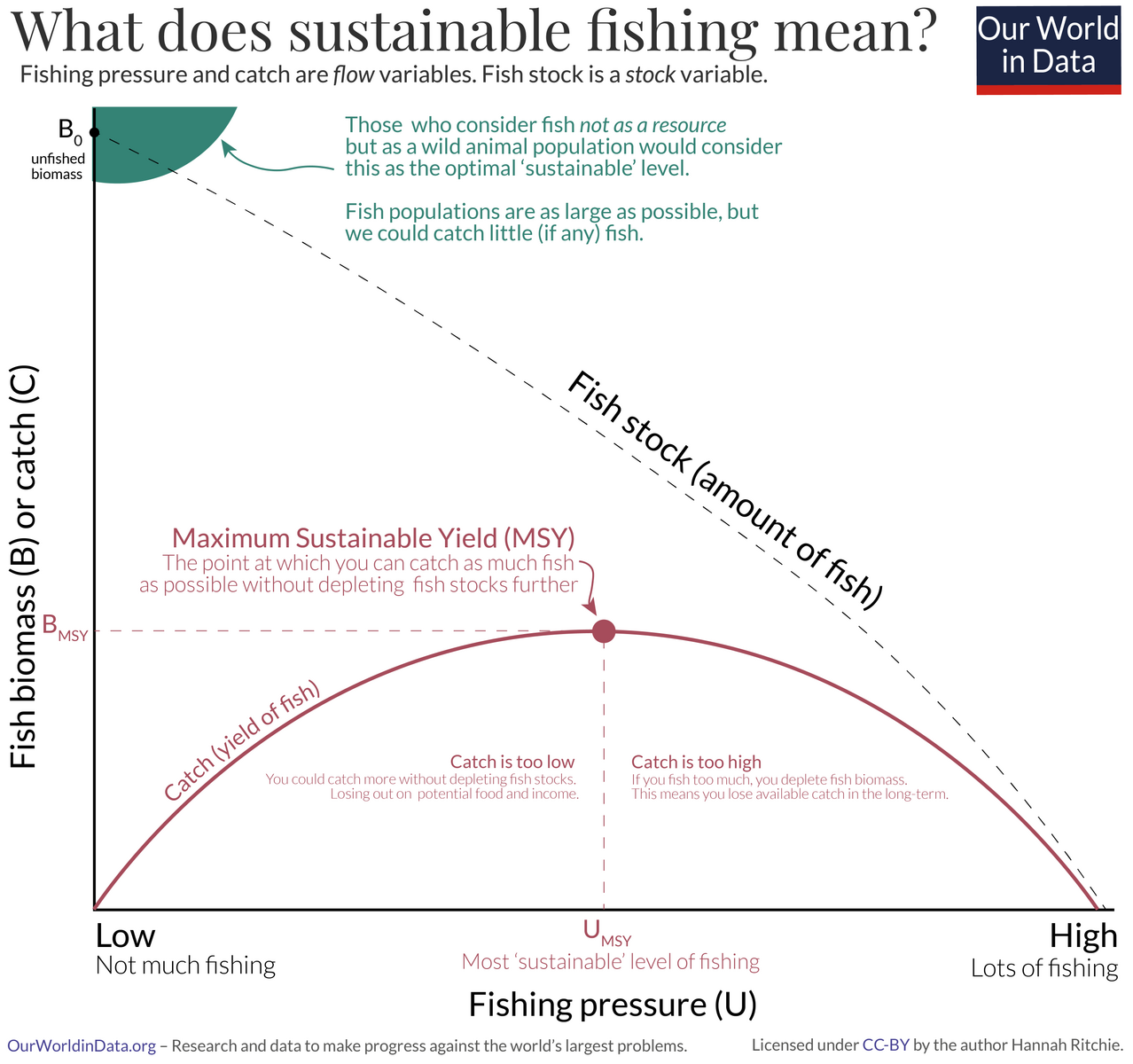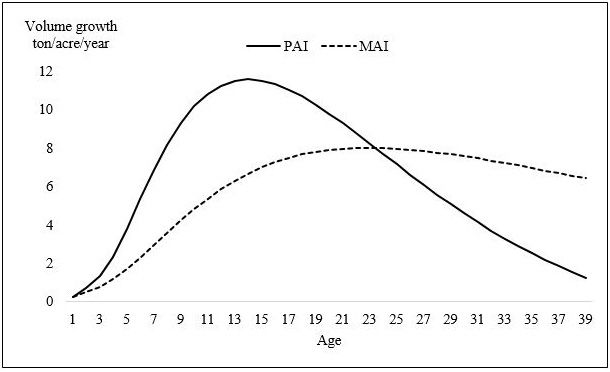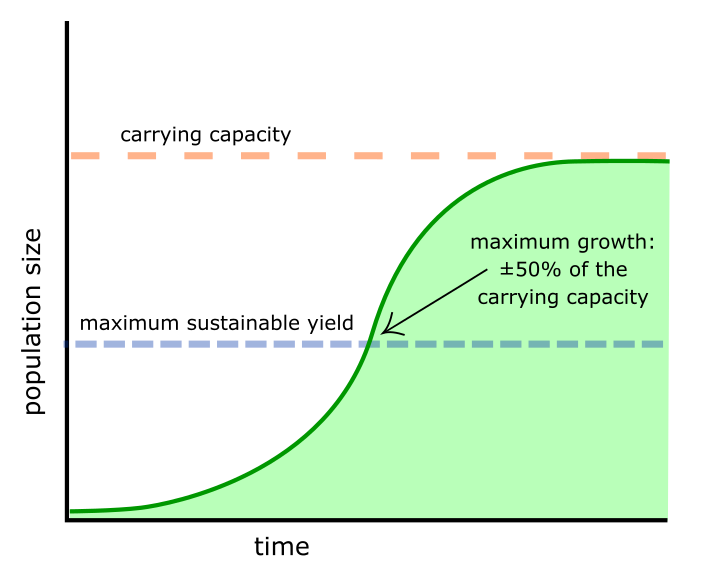IB Syllabus focus:
‘MSY equals net primary or net secondary productivity. Apply in natural ecosystems and in agricultural or silvicultural systems.’
The concept of maximum sustainable yield (MSY) is central to understanding how ecosystems can be used productively without causing long-term ecological damage. MSY establishes the balance between ecological sustainability and human use.
Understanding Maximum Sustainable Yield
Definition of MSY
Maximum Sustainable Yield (MSY): The largest yield (harvest or catch) that can be taken from a species’ stock over an indefinite period without depleting the population.
MSY relies on the principle that populations grow fastest at intermediate sizes, where resources are available, but individuals are not too limited by competition.
Relationship to Productivity
MSY is directly linked to net primary productivity (NPP) and net secondary productivity (NSP).
NPP: The energy accumulated by plants after respiration. It represents biomass available to herbivores.
NSP: The biomass gained by consumers after accounting for losses through respiration and waste.
At the ecological level, MSY reflects the maximum proportion of this productivity that can be harvested sustainably.
Natural Ecosystems and MSY
Application in Wild Populations
In natural ecosystems, MSY is applied to populations such as fish stocks, forest resources, or grazing animals. Harvesting beyond the MSY point risks overexploitation and eventual population collapse.

A fisheries MSY diagram showing how catch increases then declines with fishing pressure, while stock biomass decreases. The MSY point marks the harvest rate that maximises long-term catch without depleting the stock. The graphic includes stock and catch annotations useful for understanding fisheries controls. Source.
Key considerations:
Population size and growth rate
Environmental variability
Predator–prey interactions
Seasonal cycles and migration
Examples of Natural Applications
Fisheries: Estimating MSY involves monitoring population replenishment, breeding patterns, and mortality rates.
Forestry: Sustainable logging relies on ensuring harvested wood does not exceed regrowth.
Wild grazing: MSY ensures herbivores do not degrade vegetation beyond recovery.
Managed Systems and MSY
Agriculture
In agriculture, MSY involves determining how much crop or livestock yield can be produced without degrading soil, water, or biodiversity.
Factors influencing MSY in farming systems:
Fertiliser application rates
Irrigation and soil quality
Pest control and biodiversity management
Crop rotation and land use intensity
Silviculture (Forestry Management)
Silviculture applies MSY principles to managed forests:

Growth/yield curves (PAI and MAI) for an even-aged stand; the intersection guides the biological rotation where long-term yield is maximised without degrading the stand. While shown for slash pine, the principle generalises to managed forests for sustainable harvest planning. Source.
Harvest cycles are set to allow regrowth.
Selective cutting maintains forest age structure.
Monitoring ensures long-term productivity and ecological stability.
Ecological Basis of MSY
Logistic Growth and Carrying Capacity
MSY is derived from the concept of logistic population growth, represented by an S-curve. Populations grow rapidly at low densities, slow as they approach carrying capacity (K), and stabilise at K.
Logistic Growth Model:
dN/dt = rN (1 - N/K)
dN/dt = Change in population over time
r = Intrinsic growth rate
N = Current population size
K = Carrying capacity of the environment
MSY occurs at approximately half the carrying capacity (K/2), where the growth rate is highest.

Logistic population growth with carrying capacity (K) and the point of maximum sustainable yield (MSY) highlighted. The curve illustrates why harvest at ~K/2 maximises replenishment rate without depleting the stock. Idealised assumptions mean real populations may deviate. Source.
Factors Affecting MSY Accuracy
Estimating MSY is complex because of ecological variability. Influencing factors include:
Density-dependent controls: Competition, predation, disease
Density-independent factors: Climate events, natural disasters
Human interference: Habitat alteration, pollution, invasive species
Uncertainty in data: Population sizes and growth rates may fluctuate unpredictably
Advantages and Limitations of MSY
Advantages
Provides a quantitative basis for resource management.
Encourages sustainability by preventing overharvest.
Can be adapted for both wild and managed ecosystems.
Limitations
Assumes environmental stability, which rarely exists in reality.
Difficult to calculate due to complex population interactions.
Over-reliance on MSY may lead to ecosystem degradation if estimates are wrong.
Ignores broader ecological roles of species, such as their part in nutrient cycling or as keystone species.
Managing MSY in Practice
Monitoring Strategies
Effective use of MSY requires continuous monitoring:
Population surveys: Estimating abundance, age structure, and reproductive rates.
Productivity measurements: Tracking changes in NPP and NSP.
Environmental data: Recording abiotic conditions affecting growth.
Adaptive Management
Given uncertainty, resource managers often use precautionary approaches:
Setting harvest levels below estimated MSY.
Incorporating ecological feedbacks into planning.
Adjusting quotas and practices as new data emerge.
Sustainable Practices
In fisheries: Catch quotas, protected areas, and seasonal bans.
In agriculture: Crop rotation, soil conservation, and integrated pest management.
In forestry: Mixed-age planting, selective harvesting, and reforestation.
Key Takeaways for IB ESS Students
MSY is equal to NPP or NSP, depending on whether the system is plant- or consumer-based.
It applies in natural ecosystems (e.g., fisheries, forests) and managed systems (e.g., agriculture, silviculture).
MSY is theoretically found at half carrying capacity, but practical application is complicated by ecological variability and human impacts.
Sustainable resource management requires monitoring, precaution, and adaptation.
FAQ
MSY assumes that populations follow logistic growth patterns and that carrying capacity remains stable. It also presumes harvesting occurs evenly across populations without disproportionately targeting certain age groups.
These assumptions rarely hold true in dynamic ecosystems, where predator–prey interactions, migration, and sudden environmental shifts can disrupt predictable growth.
MSY focuses purely on the biological capacity of a population to replenish itself at maximum harvest.
OSY incorporates additional factors such as economic viability, social needs, and ecological consequences, often setting harvest levels below MSY. This makes OSY more precautionary and adaptable to uncertainty.
Marine ecosystems are vast, complex, and influenced by external drivers such as ocean currents and climate oscillations.
Fish stocks are highly mobile and often cross national boundaries.
Accurate data on reproductive rates and mortality are limited.
Illegal, unreported, and unregulated fishing can undermine estimates.
These factors make MSY calculations uncertain and prone to error.
Environmental changes such as El Niño, drought, or temperature shifts can alter reproductive rates and food availability.
This means that a harvest level sustainable in one year may lead to overexploitation the next. Fluctuations highlight the need for adaptive management rather than fixed quotas.
Monitoring typically combines biological surveys with statistical models.
Regular stock assessments measure abundance and age structure.
Acoustic surveys and catch-per-unit-effort data track fishing intensity.
Satellite monitoring and tagging provide insights into species distribution.
Such methods help adjust harvest quotas, aiming to maintain long-term sustainability.
Practice Questions
Question 1 (2 marks)
Define maximum sustainable yield (MSY).
Mark scheme:
1 mark for stating that MSY is the largest harvest or yield that can be taken indefinitely without depleting a population.
1 mark for linking MSY to the balance between population growth/replenishment and harvesting.
Question 2 (5 marks)
Explain how maximum sustainable yield (MSY) can be applied in fisheries and outline two limitations of using MSY as a management tool.
Mark scheme:
1 mark for stating that MSY is used to set fishing quotas based on population growth and replenishment rates.
1 mark for explaining that harvest levels are ideally set at half the carrying capacity, where growth is maximised.
1 mark for describing that this prevents overfishing and helps ensure long-term sustainability of stocks.
Up to 2 marks for outlining limitations:
Assumes environmental stability, which is unrealistic (1 mark).
Data on fish populations are often uncertain or variable (1 mark).
Ignores wider ecological roles of species (1 mark, maximum of 2 marks across limitations).

